Vikram Anant Rajadnya1* and Diya Amol More2
and Diya Amol More2
1Department of pharmacology, D Y Ptatil Medical College ,Kolhapur 416006 Maharashtra, India.
2D Y Ptatil Medical College ,Kolhapur 416006 Maharashtra, India.
Corresponding Author E-mail : diyamore2000@gmail.com
DOI : https://dx.doi.org/10.13005/bpj/2184
Abstract
Background: Antidiabetic drugs have to be taken for life , in majority of the patients. Price differences can lead to huge economic burden on the patients of diabetes, especially when cost considerations are not undertaken by the healthcare provider . This study was aimed to compare the annual cost a patient has to bear , of five different most commonly prescribed brands of nateglinide 60mg and four different brands of Nateglinide 120mg, in Kolhapur city. Methods: Authors purchased a strip of 10 tablets each of four leading brands of Nateglinide 120 miligrams in one city, Kolhapur,India and compared the annual cost of these four brands amonst each other . Then a strip of 10 tablets each of five leading brands of Nateglinide 60 milligrams were bought and the annual cost of these brands were compared between these five brands. These costs were compared directly as well as using percentages. The data was collected, analysed and presented. Results: The data of prices of preparations of five different bnds of a single antidiabetic drug, Nateglinide 60mg and four different brands of Nateglinide 120mg shows that the annual cost of the costliest brand among all the brands of Nateglinide 60mg is almost two times that of the cheapest brand, or it is almost 200 percent that of the cheapest brand and for Nateglinide 120mg the annual cost of costliest brand is also two times that of the cheapest brand or it is almost 200 percent that of the cheapest brand. Conclusions: There was considerable difference in the annual cost among the different brands of the drug. India being a country with majority of the population being highly price sensitive, the prescribing physician must be very careful in selecting the brands of drugs . The costliest preparation of Nateglinide can add to a significant amount on the patient’s annual budget. Thus, in a country like India, Pharmacoeconomics must have an important place while prescribing medicines.
Keywords
Annual cost; Antidiabetics; Nateglinide 60mg; Nateglinde 120mg; Pharmacoeconomics
Download this article as:| Copy the following to cite this article: Rajadnya V. A, More D. A. Cost Comparisons of Some Leading Brands of the Antidiabetic Drug, Nateglinide , Available in an Indian City. Biomed Pharmacol J 2021;14(2). |
| Copy the following to cite this URL: Rajadnya V. A, More D. A. Cost Comparisons of Some Leading Brands of the Antidiabetic Drug, Nateglinide , Available in an Indian City. Biomed Pharmacol J 2021;14(2). Available from: https://bit.ly/3fC9orx |
Introduction
Diabetes mellitus is a leading cause of morbidity and mortality world over. As per International Diabetes Fedration(IDF) estimates, there are 450 million people with Diabetes Worldwide in 2017 and figure is expected to increase to 700 million by the year 2045 (1) . The number of people with diabetes in India had increased from 26·0 mi llion (95% UI 23·4–28·6) in 1990 to 65·0 million (58·7–71·1) in 2016 (2) . Volume of sales puts India as the third globally, considering the annual sales (3). India exports medicines to many countries in the world and is manufacturing base for drugs. But at the same time this results in great price variation, likely when the government is unable to provide low cost medications to the people and they are forced to purchase such medications from the private sector (4) . As antidiabetic drugs are to be taken for life, in majority of the diabetic patients, even a small price variation results in a huge financial burden on patients especially on those who are in lower socioeconomic status of the developing countries. In India, as medical insurance is in its initial stages, more than eighty percent of healthcare expenditure is paid by the patients.
In 1997, NPPA (National Pharmaceutical Pricing Authority) was established for ensuring availability and affordability of the drugs. The drug price control order (DPCO) 2013 is one such effort under NPPA. It is noteworthy that the DPCO was implemented by the government with the aim of bringing down the cost of essential medicines (5)
This study was undertaken to evaluate the cost variation in different brands of the antidiabetic drug, Nateglinide 60mg and Nateglinide 120mg . This drug is an oral antidiabetic drug prescribed to reduce the postprandial hyperglycemia and hence taken before every meal i.e. three times a dayin majority of Indians .. The drug is initially given in dose of 120mg per dose and as the treatment continues the dose is reduced to 60mg per dose once the desired level of HbA1C is achieved (6)
Materials and Methods
Nateglinide 120 mg
This study was conducted in Kolhapur city of India. Authors purchased strips of 10 tablets each of four leading different brands of Nateglinide 120 milligram from the local market. The price paid was the M.R.P. (Maximum Retail Price). All the four strips were manufactured, within last eight months. The four different brand strips were labeled as A, B, and C, E respectively under the coding, to maintain the confidentiality of those brands. The price of the strips of 10 tablets of each brand were recorded under their specific code name.
According to MRP, the annual cost of each brand preparation was calculated for a single patient, based on three times a day dosing prescription.
This data was evaluated in the form of direct cost, as well as in percentages. While calculating the percentages, the cost of the cheapest brand preparation was taken as 100 percent, while parentages of all other preparations were calculated in comparison to the cheapest brand . Tables and bar diagrams were prepared of this data .
Inclusion criteria
Only those branded preparations, which were obtainable commonly in the local market of Kolhapur city, during the time of the study were included. All of the included drugs were available for oral intake. Brands whose Preparations contained only Nateglinide 120 milligram were selected.
Exclusion criteria
Fixed dose combinations were excluded.
Statistical methods
The prices of a strips of 10 tablets of each of the four brands were noted. On the basis of this data the cost of annual purchase based on three times daily dosing of the preparations for a single patient was calculated and the cost comparisons were done directly and in percentages. The data was presented in the form of bar graphs and tables.
Methods
Nateglinide 60 mg
This study was conducted in Kolhapur city of India. Authors purchased strips of 10 tablets each of five leading, different brands of Nateglinide 60 milligram from the local market. The price paid was the M.R.P. (Maximum Retail Price). All the five strips were recently manufactured, within last eight months. The five different brand strips were labelled as A, B, C, D, and E respectively to maintain the confidentiality of those brands. The price of the strips of 10 tablets of each brand were noted under their specific code name.
Annual cost of each brand preparation for a single patient was calculated on the basis of MRP for three times a day dosing prescription.
This data was evaluated in the form of direct cost, as well as in percentages. While calculating the percentages, the cost of the lowest priced brand preparation was considered as 100 percent, while parentages
of all other preparations were calculated in comparison to the cheapest brand . This data was presented in the form of tables, bar diagrams for better visualization.
Inclusion criteria
Only those branded preparations, which were easily available in the local market of Kolhapur city, during the time of the study were included. All of the included drugs were available for oral intake. Preparations containing only Nateglinide 60 milligram were chosen.
Exclusion criteria
Fixed dose combinations were eliminated.
Statistical methods
The prices of strips of 10 tablets of each of the five brands were noted. Based on this data the cost of annual purchase of the preparations for a single patient was calculated and the cost comparisons were done directly and in percentages. The data was presented as bar diagrams and tables.
Results
Nateglinide 120 mg
This study was conducted in Kolhapur city, in Maharashtra state, India. The strips of ten tablets of each of the four leading brand preparations of Nateglinide 120 milligram, were purchased from the local market. All the brand preparations were recently manufactured. All the brand preparations were labelled under the code names A, B, C and E respectively . The cost for ten tablets, the cost of one tablet, the annual cost to a single patient, on the basis of three times daily dosing were calculated in direct figures and in percentages. Thus, it is observed that brand B is the cheapest one while brand A is the costliest one amongst the four brands. The costs of the remaining brands i.e. brand C and brand E, comes in between. It is also observed that the costliest brand costs almost about two times or almost 200 percent of that of the cheapest brand.
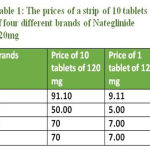 |
Table 1: The prices of a strip of tablets of four different brands of Nateglinide 120 mg |
Table 1 shows, the prices for 10 tablets as well as one tablet of each of the four brand preparations of Nateglinide 120mg under the allotted code names. Thus, it can be seen that the brand B provides the drug Nateglinide 120mg, the cheapest, costing 50.00 rupees for 10 tablets, while costing 5.00 rupees for a single tablet. Similarly brand A is the costliest among all four, costing 91.10 rupees for 10 tablets and 9.11 rupees for single tablet. The remaining two brands (C and E)have the same costs.
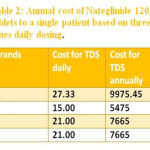 |
Table 2: Annual cost of Nateglinide tablets to a single patient based on time daily dosing |
Table 2 shows the annual cost of each of the four brand preparations , for a single patient , based on three times daily dosing . Thus it can be observed that the cheapest, i.e. brand B costs 5475 rupees annually, for a single patient based on a one tablet three times daily basis, while the costliest brand, i.e. brand A costs 9975.45 rupees for a single patient based on three tablets daily dosing. The cost variation between the cheapest and the costliest brand is about two times. The annual cost of remaining two brands viz, C and E fall in between that is 7665 rupees each.
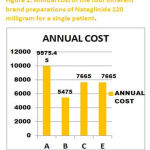 |
Figure 1: Annual cost of the four different brand preparations of Nateglinide 120 mg tablets to a single patient. |
Figure 1 depicts shows the annual cost of each of the four brand preparations , for a single patient , based on three times daily dosing . Thus it can be observed that the cheapest, i.e. brand B costs 5475 rupees annually, for a single patient based on a one tablet three times daily basis, while the costliest brand, i.e. brand A costs 9975.45 rupees for a single patient based on three tablets daily dosing. The cost variation between the cheapest and the costliest brand is about two times. The annual cost of remaining two brands viz, C and E fall in between that is 7665 rupees each.
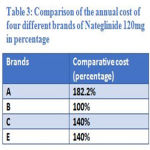 |
Table 3: Comparison of the annual cost of foure different brands of nateglinide 120 mg in parcentage. |
Table 3 shows the annual cost comparisons for a single patient, based on a single tablet three times daily basis of all the four brands. This is presented in the form of percentages. Thus, it can be observed that the brand B, the cheapest amongst all four brands is considered to cost 100 percent. In this regard, the costliest brand, i.e. brand A costs 182.2 percent as compared to brand B. Remaining two brands cost as follows: 140 percent for brand C and 140 percent for brand E.
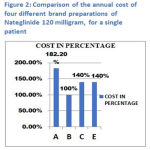 |
Figure 2: Comparison of the annual cost of four different brands preparations of nateglinide 120 mg to a single patient |
Figure 2 presents the annual cost comparisons for a single patient, based on a single tablet three times daily basis of all the four brands. This is presented in the form of percentages. Thus, it can be seen that the brand B, the cheapest amongst all four brands is considered to cost 100 percent. In this regard, the costliest brand, i.e. brand A costs 182.2 percent as compared to brand B. Remaining two brands cost as follows: 140 percent for brand C and 140 percent for brand E.
Results
Nateglinide 60mg
The current study was conducted in Kolhapur city, in Maharashtra state, India. The strips of ten tablets of each of the five leading brand preparations of Nateglinide 60 milligram, were purchased from the local market. All the brand preparations were recently manufactured. All the brand preparations were designated under the code names A, B, C, D and E respectively. The cost for ten tablets, the cost of one tablet, the annual cost to a single patient, based on single daily dosing were calculated in direct figures and in percentages. Thus, it is observed that brand A is the cheapest one while brand C is the costliest amongst all. The prices of the remaining brands i.e. brands B, D and E, fall in between. It is also seen that the costliest brand cost almost two times or 200 percent more than the cheapest brand.
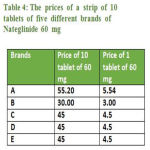 |
Table 4: the prices of a strip of 10 tablets of five different brands of Nateglinide 60 mg. |
Table4 depicts, the prices for 10 tablets as well as of one tablet of each of the five brand preparations under the specified code names. Thus, it can be seen that the brand B provides the drug Nateglinide60 mg, the cheapest, costing 30.00 rupees for 10 tablets, while costing 3.00 rupees for a one tablet. In contrast brand A is the costliest among all five, costing 55.20 rupees for 10 tablets and 5.54 rupees for single tablet. And the remaining three brands, C, D and E have the same costs .
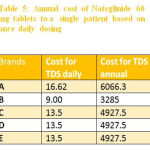 |
Table 5: Annual cost of Nateglinide tablets to a single patient based once daily dosing |
Table 5 represents the annual cost of each of the five brand preparations , for a single patient , based on single daily dosing . Thus it can be observed that the cheapest, i.e. brand B costs 3285 rupees annually, for a single patient taking single tablet three times daily , while the costliest brand, i.e. brand A costs 6066.3 rupees for a single patient based on one tablet three times daily dosing. The cost variations between the cheapest and the costliest brand is almost two times. The annual costs of the remaining three brands viz, C, D, E fall in between that is 4927.5rupees each.
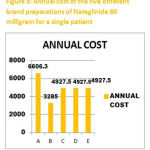 |
Figure 3: Annual cost of the five different brand preparations of Nateglinide 60 mg for a single patient |
FIGURE 3 represents the annual cost of each of the five brand preparations , for a single patient , based on single daily dosing . Thus it can be observed that the cheapest, i.e. brand B costs 3285 rupees annually, for a single patient taking single tablet three times daily , while the costliest brand, i.e. brand A costs 6066.3 rupees for a single patient based on one tablet three times daily dosing. The cost variations between the cheapest and the costliest brand is almost two times. The annual costs of the remaining three brands viz, C, D, E fall in between that is 4927.5rupees each.
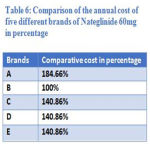 |
Table 6: Comparison of the annual cost of five different brands of nateglinide 60 mg in parcentage. |
Table 6 presents the annual cost comparisons for a single patient, based on a single tablet three times daily basis of all the five brands. This is converted in the form of percentage in such a way that the brand B, the cheapest amongst all five brands is considered to cost 100 percent. Hence , the costliest brand, i.e. brand A costs 184.66 percent as compared to brand B. Remaining three brands cost as follows: 140.86 percent for brand B, 140.86 percent for brand D and 140.86 percent for brand E.
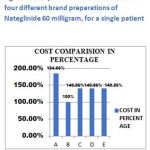 |
Figure 4: Comparison of the annual cost of four different brands preparations of nateglinide 60 mg for a single patient. |
Figure 4 presents the annual cost comparisons for a single patient, based on a single tablet three times daily basis of all the five brands. This is converted in the form of percentage such a way that the brand B, the cheapest amongst all five brands is considered to cost 100 percent. Hence , the costliest brand, i.e. brand A costs 184.66 percent as compared to brand B. Remaining three brands cost as follows: 140.86 percent for brand B, 140.86 percent for brand D and 140.86 percent for brand E
Discussion
Management of Diabetes Mellitus in Indian patients includes lifestyle modification, which in turn includes adequate nutrition and dietary changes, exercise, yoga and stress management (7) . Drugs are prescribed only when the above lifestyle modifications fail to maintain the blood sugar level or could not be adapted due to various reasons.
When the drug therapy becomes necessary the drugs acting by increasing first phase of insulin secretion are used to prevent post prandial hyperglycaemia (8) This group of drugs include Meglinitide/D-phenylalanine analogues(kATP channel blocker) such as Nateglinide and sulfonylurease such as Gliclazide. These are some of the most commonly prescribed and popular antidiabetic drugs to prevent postprandial hyperglycaemia in diabetes (9)
Profit margin of pharmaceutical companies shows extreme variations, often ranging from 1000% to 4000% (10) . In 1995, the first Drug Price Control Order (DPCO-1995) was issued which included the prices of seventy six drugs under the price control (11) . For the benefit of patients, government authorizes the NPPA to regulate prices of medicines which are included in the National List of Essential Medicines (NLEM) in 2013 i.e. 348 essential medicines. Government is trying its level best for ensuring availability and affordability of medicines for all citizens of India. The order authorized the NPPA to regulate the medicine prices of not only NLEM but also medicines which are not listed in NLEM (non-NLEM) (12) .But even after these efforts there is are great price differences and some drug brand preparations still cost more than the other brands. Every pharmaceutical company desires to quote its own price of the medicines they manufacture without hampering their profit margin (13) . In the USA there is no strict price regulation and thus the drug companies are willing to invest more on research and development (14)
But for the sake of society there must be a regulatory system. This is even more important in India as there is no well-defined social security system. In addition medical insurance coverage is very poor and most of the health-related expenditures are borne by the patients themselves. About 39 million Indians are facing great economic burden every year due to rising health care costs and 30% patients die at home following discharge against medical advice from the intensive care units due to non-affordability of treatment (15)
In the present study the difference in annual cost of Nateglinide 60 mg and 120 mg for a single patient ranges between 100 percent to 200 percent each between the cheapest and the costliest brand amongst those selected for this study. Thus, while prescribing Nateglinide 60mg or 120mg to the patient, the Pharmacoeconomics of this drug must be considered. Prescribing costlier brand preparations, without being reasonable to the patients must be discouraged, especially in a country like India.
Thus, it might be stated that every physician must work on pharmacoeconomics of drugs, especially for conditions like diabetes mellitus , where drug treatment might be required for many years or many times for life. responsibility of all medical professionals that cost effectiveness of drugs should be analysed before prescribing it to any patient.
Among many factors , the cost considerations must hold a very high priority while prescribing , in a country like India .
Acknowledgement
We are thankful to the D Y Patil Medical college , Kolhapur for providing us the opportunity to work in this area of research.
Conflict of interest
None Authors do not have any conflict of interest whatsoever , including those related to honorarium, grants, membership, employment, ownership of stock or any other interest or non‐financial interest such as personal or professional relation, affiliation and knowledge of the research topic.
Funding Source
There is no funding source whatsoever for any part of this original research project.
References
- Harsh Mohan Textbook of PATHOLOGY 8th Ed ,2019,pp 860.
- Nikhil Tandon , Lalit Dandona et al ; The increasing burden of diabetes and variations among thestates of India: the Global Burden of Disease Study1990–2016.India State Level Disease Burden Initiative Diabetes Collaborators Lancet Glob Health 2018;6: e1352–62Published OnlineSeptember 12, 2018. Available at http://dx.doi.org/10.1016/ S2214-109X(18)30387-5
- Banerji A. Review of Asia-Pacific’s healthcare systems with emphasis on the role of generic pharmaceuticals. Academy of Health Care Management J. 2013;9(1/2):53A.
- Kotwani A, Ewen M, Dey D, Iyer S, Lakshmi PK, Patel A, et al. Prices and availability of common medicines at six sites in India using a standard methodology. Indian J Med Res. 2007;125(5):645-54.
- DPCO, Drug Price Control Order 2013 – National Pharmaceutical Pricing Authority; 2013. Available at: http://www.arthapedia.in
- Indications and Usage for Nateglinide ; medically reviewed by Drugs.com. Last updated on Oct 1, 2019. Available at https://www.drugs.com/pro/nateglinide.html
- KD Tripathi Essentials of MEDICAL PHARMACOLOGY 8th Ed, 2019, pp301-304.
- KD Tripathi Essentials of MEDICAL PHARMACOLOGY 8th Ed ,2019,pp294-297
- Ahmad A, Patel I, Sanyal S, Balkrishnan R, Mohanta GP. Availability, cost and affordability of antimalarial medicines in India. Int J Pharm Clin Res. 2014;6(1):7-12.
- Harvard School of Public Health, Boston, MA, USA. How Effective Is India’s Drug Price Control Regime? 2007. Available at: https://cdn1.sph.harvard.edu/wp-content/uploads/sites/114/2012/10/RP256.pdf.
- Sahay A, Jaikumar S. Does pharmaceutical price regulation result in greater access to essential medicines? Study of the impact of drug price control order on sales volume of drugs in India. Research and publication of Indian Institute of management, Ahmadabad. W.P.2016-02-01, Jan 2016;1-28.
- DPCO Impact: Pharma cos growth suffers for drugs under price ceiling/ Business Standard News, 2013. Available at: https://www.business-standard.com/article/companies/dpco-impact-pharma-cos-growth-suffers-for-drugs-under-price-ceiling-113081800677_1.html.
- Vernon, John A, Golec JH, and Hughen WK. The Economics of Pharmaceutical Price Regulation and Importation: Refocusing the Debate. Amer J Law Medi. 2006;32(2-3):175-92.
CrossRef - Balarajan Y, Selvaraj S, Subramanian SV. Health care and equity in India. Lancet. 2011;377(9764):505-15.
CrossRef








